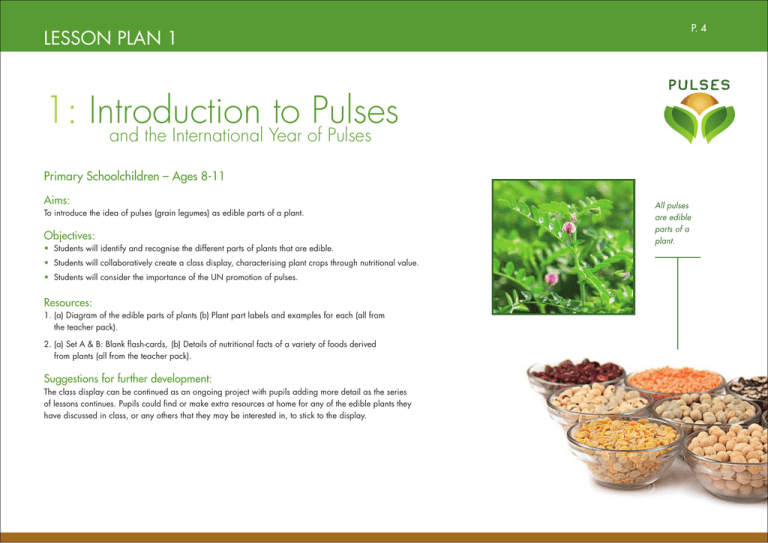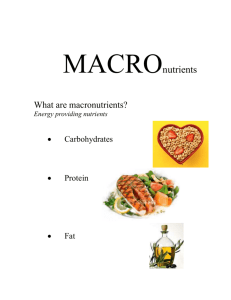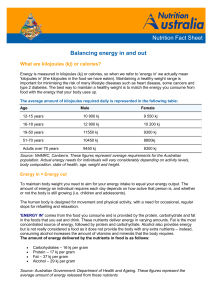1: Introduction to Pulses - 2016 International Year of Pulses
advertisement

P. 4 LESSON PLAN 1 1: Introduction to Pulses and the International Year of Pulses Primary Schoolchildren – Ages 8-11 Aims: To introduce the idea of pulses (grain legumes) as edible parts of a plant. Objectives: • Students will identify and recognise the different parts of plants that are edible. • Students will collaboratively create a class display, characterising plant crops through nutritional value. • Students will consider the importance of the UN promotion of pulses. Resources: 1. (a) Diagram of the edible parts of plants (b) Plant part labels and examples for each (all from the teacher pack). 2. (a) Set A & B: Blank flash-cards, (b) Details of nutritional facts of a variety of foods derived from plants (all from the teacher pack). Suggestions for further development: The class display can be continued as an ongoing project with pupils adding more detail as the series of lessons continues. Pupils could find or make extra resources at home for any of the edible plants they have discussed in class, or any others that they may be interested in, to stick to the display. All pulses are edible parts of a plant. P. 5 LESSON PLAN 1 1: Introduction to Pulses and the International Year of Pulses TIME DETAILS TIME DETAILS 15mins Introduction: Explore the pupils’ knowledge of the different parts of plants that are edible: what different parts of plants have you eaten? Explain to your pupils how the edible parts of plants are categorised and what the different categories are, with examples in each (resource 1a). Ask the pupils to write down a type of food (plant) they have eaten on a piece of paper, and place onto the correct plant part label (resource 1b). You can spread these labels out around the room. How many pupils have eaten the following (‘pulses’ or ‘legumes’): kidney beans, chickpeas (the main ingredient in hummus), navy beans (often used to make ‘baked beans’), butter beans, mung beans (also known as ‘beansprouts’ after germinating), broad beans, lima beans, lentils (often used to make ‘dhal’)? Compare their answers to other seeds they may have eaten. Does the comparison surprise them in any way? Teacher note on pulses: the seeds of plants can be sub-divided into several catagories, including ‘pulses (or legumes)’, ‘cereals’ and ‘nuts’. 10mins In pairs, pupils will use resource 2 to create flash-cards for five different foods (derived from plants); extracting key information from tables in order to fill in the relevant nutritional data on the cards. Teacher needs to distribute either set A or B vegetables to different pairs of children. 10mins Pairs of pupils play ‘top-trumps’ with their set of cards against another pair (A vs. B) - can you select a nutritional category for which you have a higher quantity than your opponents? If you can then you win their card. The pair which has collected the highest number of cards after a set time, wins. 10mins Whole class activity: starting with their flash-cards, pupils build-up a class display, showing the different categories of edible plants. The following website can be used to find the full nutritional content of a huge number of different foods. The search box is particularly useful: http://nutritiondata.self.com/ 15mins Further Information Grains, lentils and pulses are all widely available to buy in grocery stores, supermarkets and health food stores. Extension: add any additional details from the resource sheets (resource 2) or from the internet. Pupils can perform further research at home and add to the display in subsequent lessons. Which vegetables and pulses are the pupils’ favourites, which do they eat the least, and which do they know least about? Reflecting on this discussion, ask pupils to select a type of vegetable to make a short promotional sketch/advert to inspire their classmates to eat more of that vegetable. What might it be important to include in the promotion? Listen to some of the pupils promotions. Explain that the UN chooses different food-types to promote globally – why might they do this, and why do you think pulses have been chosen for this year’s promotion (the UN International Year of Pulses)? P. 6 LESSON PLAN 1 Resource 1a. The edible parts of a plant LEAF FLOWER SEEDS STEM ROOTS FRUIT P. 7 LESSON PLAN 1 Resource 1b. Plant part labels and examples for each ROOT STEM LEAF • Beetroot • Asparagus • Cabbage • Carrot • Celery • Chicory • Turnip • Leek • Lettuce • Cassava • Onion • Kale • Radish • Potato • Spinach FLOWER FRUIT SEED • Broccoli • Strawberry • Lentil • Bergamot • Tomato • Broad Bean • Cauliflower • Mango • Pea • Chamomile • Orange • Rice • Dill • Pomegranate • Wheat P. 8 LESSON PLAN 1 Resource 2a. Blank Flash Cards (Pack A) CHICKPEAS TOMATO (100g) Calories Kilojoules (100g) Calories 1523 Kilojoules Fat Fat Carbohydrates Carbohydrates Fibre Fibre Protein Protein 75 P. 9 LESSON PLAN 1 Resource 2a. Blank Flash Cards (Pack A) CARROT CABBAGE (100g) Calories Kilojoules (100g) Calories 172 Kilojoules Fat Fat Carbohydrates Carbohydrates Fibre Fibre Protein Protein 105 P. 10 LESSON PLAN 1 Resource 2a. Blank Flash Cards (Pack A) ASPARAGUS LENTILS (100g) Calories Calories Kilojoules (100g) 84 Kilojoules Fat Fat Carbohydrates Carbohydrates Fibre Fibre Protein Protein 1477 P. 11 LESSON PLAN 1 Resource 2a. Blank Flash Cards (Pack A) STRAWBERRY BEETROOT (100g) Calories Calories Kilojoules (100g) 134 Kilojoules Fat Fat Carbohydrates Carbohydrates Fibre Fibre Protein Protein 180 P. 12 LESSON PLAN 1 Resource 2a. Blank Flash Cards (Pack A) SPINACH ONION (100g) Calories Kilojoules (100g) Calories 96 Kilojoules Fat Fat Carbohydrates Carbohydrates Fibre Fibre Protein Protein 167 P. 13 LESSON PLAN 1 Resource 2a. Blank Flash Cards (Pack B) CHICKPEAS TOMATO (100g) Calories Kilojoules (100g) Calories 1523 Kilojoules Fat Fat Carbohydrates Carbohydrates Fibre Fibre Protein Protein 75 P. 14 LESSON PLAN 1 Resource 2a. Blank Flash Cards (Pack B) CARROT CABBAGE (100g) Calories Kilojoules (100g) Calories 172 Kilojoules Fat Fat Carbohydrates Carbohydrates Fibre Fibre Protein Protein 105 P. 15 LESSON PLAN 1 Resource 2a. Blank Flash Cards (Pack B) ASPARAGUS LENTILS (100g) Calories Calories Kilojoules (100g) 84 Kilojoules Fat Fat Carbohydrates Carbohydrates Fibre Fibre Protein Protein 1477 P. 16 LESSON PLAN 1 Resource 2a. Blank Flash Cards (Pack B) STRAWBERRY BEETROOT (100g) Calories Calories Kilojoules (100g) 134 Kilojoules Fat Fat Carbohydrates Carbohydrates Fibre Fibre Protein Protein 180 P. 17 LESSON PLAN 1 Resource 2a. Blank Flash Cards (Pack B) SPINACH ONION (100g) Calories Kilojoules (100g) Calories 96 Kilojoules Fat Fat Carbohydrates Carbohydrates Fibre Fibre Protein Protein 167 P. 18 LESSON PLAN 1 Resource 2b. Nutritional Information Chickpeas Tomato Carrot Cabbage Asparagus P. 19 LESSON PLAN 1 Resource 2b. Nutritional Information Lentils Strawberry Beetroot Spinach Onion




